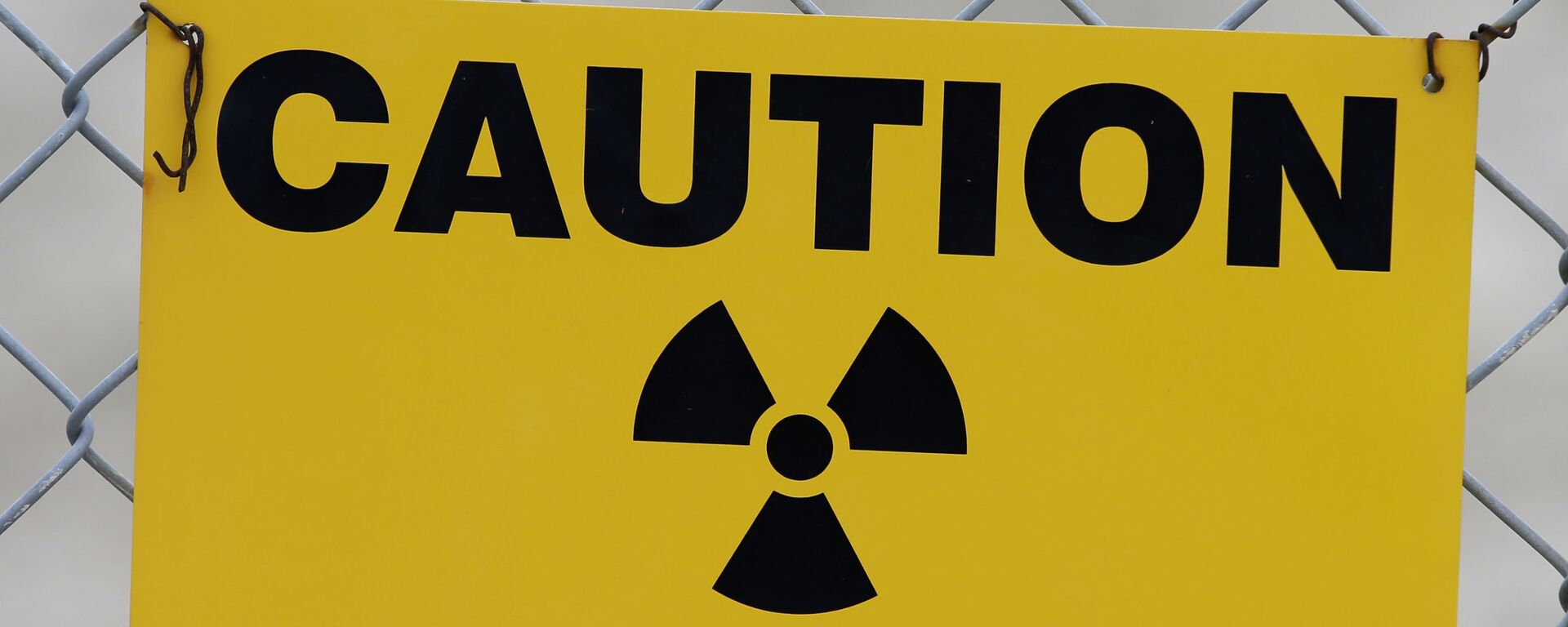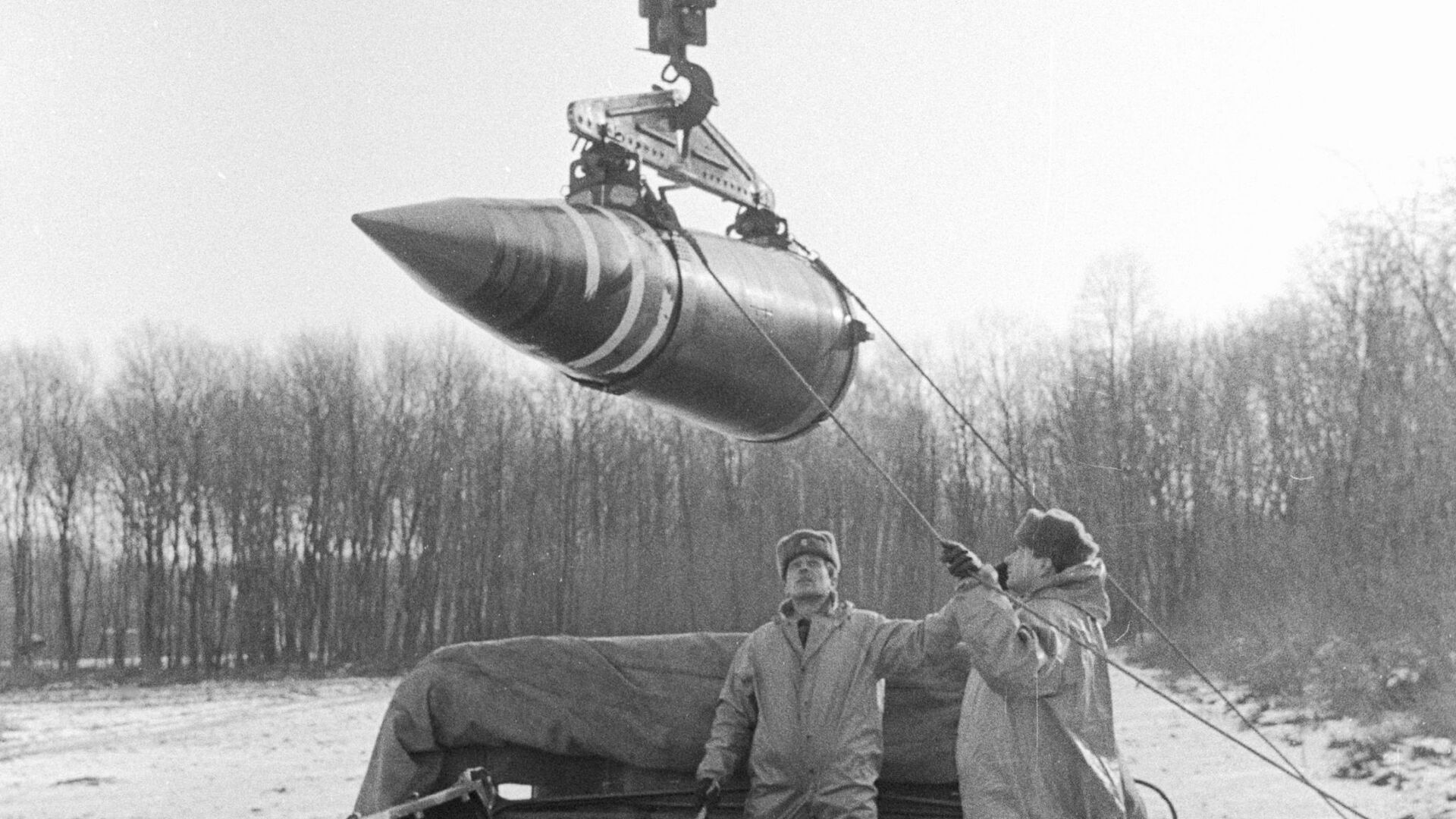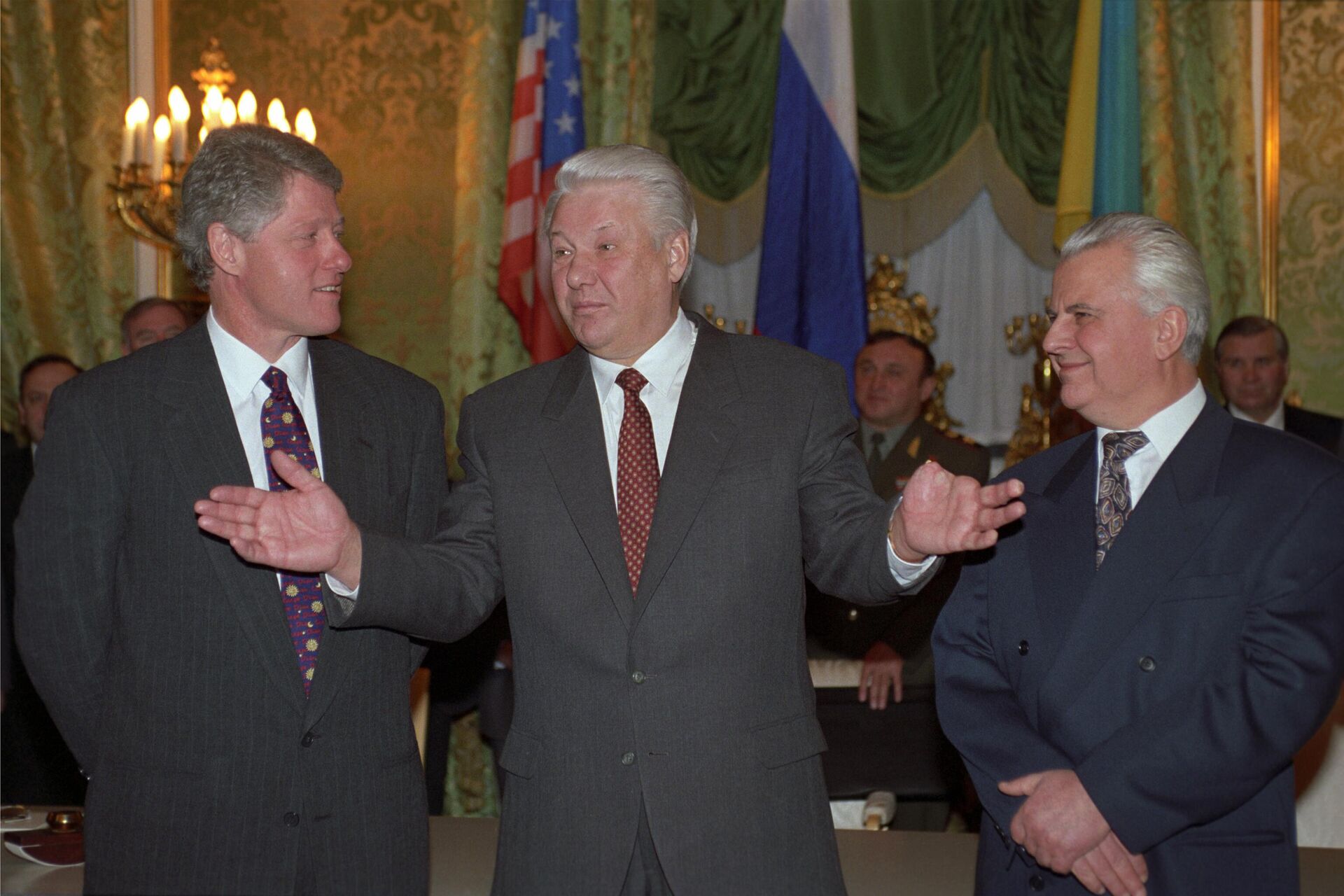https://sputnikglobe.com/20230114/from-no-nukes-pledge-to-dirty-bombs-how-kiev-broke-its-promise-to-reject-nuclear-weapons-1106324715.html
From No Nukes Pledge to Dirty Bombs: How Kiev Broke Its Promise to Reject Nuclear Weapons
From No Nukes Pledge to Dirty Bombs: How Kiev Broke Its Promise to Reject Nuclear Weapons
Sputnik International
20 years after the signing of an agreement on the handover of Ukraine's nuclear arsenal to Russia, Moscow is accusing its neighbor of working on a dirty bomb. How did the region's security transformed into insecurity?
2023-01-14T18:45+0000
2023-01-14T18:45+0000
2023-01-14T20:11+0000
ukraine
us
russia
nuclear
nuclear weapons
nuclear plant
nuclear power
nuclear arms
nuclear armaments
dirty bomb
https://cdn1.img.sputnikglobe.com/img/07e5/04/0f/1082640820_0:512:2049:1664_1920x0_80_0_0_37dd2ba2a9eefb5ea8dba254e10436be.jpg
Twenty-nine years ago today, on January 14, 1994, Russian President Boris Yeltsin and his US counterpart Bil that Kiev was actively working on a nuclear weapon, and already had technical potential and know-how greater than North Korea or Iran. In October, the Russian military said it The agreements, hailed by Yeltsin as “a great boost to the goal of a nuclear disarmament,” committed Moscow and Washington to de-target the vast nuclear arsenals they had aimed at one another, and committed Ukraine to hand over its vast stocks of nuclear weapons left over from Soviet days to Russia for destruction.After the USSR's destruction, Kiev was left with over 1,700 nuclear warheads, more than 200 intercontinental ballistic missiles and a fleet of 38 heavy strategic bombers. This arsenal made Ukraine de facto the world’s third most powerful nuclear weapons state, with enough firepower to singlehandedly wipe out the planet. But Kiev didn’t have the launch codes to the nukes, which were controlled via the Russian equivalent of the US ‘nuclear football’ by President Yeltsin.No More NukesSeeking to get Ukraine’s relations with its European neighbors off on the right foot, and intent on joining the non-Proliferation Treaty as a non-nuclear weapons state, then-Ukrainian President Leonid Kravchuk agreed to a Russian and US-proposed initiative to remove the nukes from Ukrainian territory, and compensate Kiev with enough fuel assemblies to power its network of nuclear power plants for over a decade. The removed nukes were to be melted down by Russia, with some of the fuel even ending up powering NPPs in the US in a ‘deal of the century’-style agreement between Vice President Al Gore and Russian Premier Viktor Chernomyrdin.Kravchuk joined Yeltsin and Clinton at the January 14, 1994 nuclear accords signing ceremony, and in joint statement, the three leaders pledged to deliver Ukraine’s nukes to Russia “in the shortest time possible.” Russia and the US pledged to respect Ukrainian independence and vowed to never use nuclear weapons against the country.Eleven months later, at an Organization for Security Co-Operation in Europe conference in December 1994, Russia, the US, the UK, Belarus, Kazakhstan and Ukraine signed the Budapest Memorandum on Security Assurances – a set of treaties providing security guarantees to the latter three countries on their accession to the NPT.The memorandum committed Russia, the US and Britain to “reaffirm their obligation to refrain from the threat or use of force against the territorial integrity or political independence of Ukraine,” and from the use of armed force against the country “except in self-defense or otherwise in accordance with the Charter of the United Nations.” The guarantors also pledged to provide assistance through United Nations channels “if Ukraine should become a victim of an act of aggression or an object of a threat of aggression in which nuclear weapons are used.”Ukraine completed the transfer of its nuclear weapons to Russia in June 1996, and eliminated its delivery systems by 2001.Did Russia Violate the Budapest Memorandum?After the escalation of the security crisis in the Donbass in February 2022 into a full-on conflict between Russia and Ukraine, Ukrainian officials and their Western sponsors have used the 1994 memorandum as a ‘gotcha!’ moment against Moscow, accusing Russia of violating both the spirit and letter of the agreement with its ‘special military operation.’However, observers quickly found holes in Kiev’s arguments. For openers, Ukraine’s rejection of nuclear weapons was codified in the republic’s Declaration of State Sovereignty of July 1990, which pledged Kiev “not to accept, produce, or acquire nuclear weapons,” and to adhere to a policy of strict neutrality. In other words, even before the trilateral statement and the Budapest Memorandum were signed, Ukraine was already committed to giving up the nuclear weapons on its territory – which Kiev was never in control over anyway.Ukraine’s pledge to preserve ‘neutrality’ was chipped away at over the past twenty years, first after the ‘Orange Revolution’ in 2005 by President Viktor Yushchenko, who oriented the country toward eventual membership in NATO and the European Union. Then, after the US-sponsored coup in Kiev in February 2014, neutrality went straight into the dustbin of history when the country’s constitution was amended to include the “strategic course” of joining the EU and the Western military bloc.No, More NukesIn February 2022, just a few days before Russia kicked began its military operation in Ukraine, Ukrainian President Volodymyr Zelensky gave a speech at the Munich Security Conference, announcing that he would be initiating consultations under the Budapest Memorandum, and signaling that Ukraine may revoke its non-nuclear weapons status.“Ukraine has received security guarantees for abandoning the world’s third nuclear capability. We don’t have that weapon. We also have no security. We also do not have part of the territory of our state that is larger in area than Switzerland, the Netherlands or Belgium. And most importantly – we don’t have millions of our citizens. We don’t have all this. Therefore, we have something: The right to demand a shift from a policy of appeasement to ensuring security and peace guarantees,” Zelensky said at the time.“I am initiating consultations in the framework of the Budapest Memorandum. The minister of foreign affairs was commissioned to convene them. If they do not happen again or their results do not guarantee security for our country, Ukraine will have every right to believe that the Budapest Memorandum is not working and that all the package decisions of 1994 are in doubt,” he warned.President Putin addressed Zelensky’s comments in a speech shortly after, saying Ukraine had both the technical competency and capabilities to build a nuclear weapon, and stressing that Moscow would consider even attempts to create a tactical nuclear device by a neighbor that questions Russia’s territorial integrity as a “strategic threat” to Russia.Intel on Ukrainian Nuclear and Dirty Bomb ResearchA few weeks later, in March of 2022, Russian Foreign Intelligence announced that it had obtained information that Kiev was actively working on a nuclear weapon, and already had technical potential and knowhow greater than North Korea or Iran. In October, the Russian military said it had intelligence on contacts between the Ukrainian president’s office and British officials on Ukraine’s possible acquisition of nuclear weapons technology.Also in October, Defense Minister Sergei Shoigu accused Kiev of “planning a provocation involving the detonation of a so-called ‘dirty bomb’, or a low-yield nuclear weapon” to accuse Russia of using a tactical nuke on Ukrainian territory. Shoigu conveyed this information to senior US, UK, French and Turkish officials, presumably to deny NATO plausible deniability in the event that the false flag attack actually proceeded. Western officials dismissed Russia’s concerns and issued a joint statement saying they were based on “transparently false allegations.” But the contents of any private conversations they may have had with their clients in Kiev remain unknown.To date, no further information has come to light on Kiev’s work on nuclear weapons, or the dirty bomb allegations by the Russian military. The International Atomic Energy Agency (IAEA) announced last week that inspectors recently dispatched to Ukraine had found “no indications of undeclared nuclear activities or materials” at three sites they had inspected. However, the sites were opened for inspection by Ukrainian authorities themselves for “safeguards checks,” and are just a fraction of Ukraine’s overall nuclear facilities – which include three research institutes, four nuclear power plants, waste storage sites and a sprinkling of uranium mines situated in the central Ukrainian region of Kirovograd.Hopeful Sign?In one hopeful note, the IAEA announced Friday that it would step up efforts “to help prevent a nuclear accident” in Ukraine by deploying a permanent presence “at all of Ukraine’s nuclear facilities, including Chernobyl.” However, this doesn’t appear to account for the non-power generating nuclear facilities mentioned above.IAEA Director General Mario Grossi plans to travel to Kiev next week for meetings with senior officials, and is expected to outline a nuclear ‘safety and security protection zone’ around the Zaporozhye Nuclear Power Plant –where IAEA specialists are already present – and which has been shelled repeatedly by Ukrainian artillery after coming under Russia’s control last March.
https://sputnikglobe.com/20221105/kiev-never-concealed-it-could-make-nukes--west-is-abetting-it-journo-says-1103811709.html
https://sputnikglobe.com/20221107/head-of-us-nuclear-forces-claims-ukraine-just-a-warmup-for-very-long-struggle-with-russia-china-1103870150.html
https://sputnikglobe.com/20230107/iaea-consultations-with-agencys-director-general-on-zaporozhye-nuclear-power-plant-remain-ongoing-1106094620.html
ukraine
russia
Sputnik International
feedback@sputniknews.com
+74956456601
MIA „Rosiya Segodnya“
2023
News
en_EN
Sputnik International
feedback@sputniknews.com
+74956456601
MIA „Rosiya Segodnya“
Sputnik International
feedback@sputniknews.com
+74956456601
MIA „Rosiya Segodnya“
ukraine, united states, soviet union, russia, nuclear weapons, nuclear power, nuclear facilities, nuclear capabillities, nuclear arms, weapons, arms, nuclear
ukraine, united states, soviet union, russia, nuclear weapons, nuclear power, nuclear facilities, nuclear capabillities, nuclear arms, weapons, arms, nuclear
From No Nukes Pledge to Dirty Bombs: How Kiev Broke Its Promise to Reject Nuclear Weapons
18:45 GMT 14.01.2023 (Updated: 20:11 GMT 14.01.2023) Almost thirty years after the signing of a landmark agreement on the handover of Ukraine's Soviet-built nuclear arsenal to Russia, Moscow is accusing its neighbor of working on nukes and a radioactive dirty bomb. How did the region's strategic security transform into insecurity? Sputnik explains.
Twenty-nine years ago today, on January 14, 1994, Russian President Boris Yeltsin and his US counterpart Bil that Kiev was actively working on a nuclear weapon, and already had technical potential and know-how greater than North Korea or Iran. In October, the Russian military said it
The agreements,
hailed by Yeltsin as “a great boost to the goal of a nuclear disarmament,” committed Moscow and Washington to de-target the vast nuclear arsenals they had aimed at one another, and committed Ukraine to hand over its vast stocks of nuclear weapons left over from Soviet days to Russia for destruction.
After the USSR's
destruction, Kiev was left with
over 1,700 nuclear warheads, more than 200 intercontinental ballistic missiles and a fleet of 38 heavy strategic bombers. This arsenal made Ukraine de facto the world’s third most powerful nuclear weapons state, with enough firepower to singlehandedly wipe out the planet.
But Kiev didn’t have the launch codes to the nukes, which were controlled via the Russian equivalent of the US ‘nuclear football’ by President Yeltsin.Seeking to get Ukraine’s relations with its European neighbors off on the right foot, and intent on joining the non-Proliferation Treaty as a non-nuclear weapons state, then-Ukrainian President Leonid Kravchuk agreed to a Russian and US-proposed initiative to remove the nukes from Ukrainian territory, and compensate Kiev with enough fuel assemblies to power its network of nuclear power plants for over a decade. The removed nukes were to be melted down by Russia, with some of the fuel even ending up powering NPPs in the US in a
‘deal of the century’-style agreement between Vice President Al Gore and Russian Premier Viktor Chernomyrdin.
Kravchuk joined Yeltsin and Clinton at the January 14, 1994 nuclear accords signing ceremony, and in joint statement, the three leaders pledged to deliver Ukraine’s nukes to Russia “in the shortest time possible.” Russia and the US pledged to respect Ukrainian independence and vowed to never use nuclear weapons against the country. Eleven months later, at an Organization for Security Co-Operation in Europe conference in December 1994, Russia, the US, the UK, Belarus, Kazakhstan and Ukraine signed the Budapest Memorandum on Security Assurances – a set of treaties providing security guarantees to the latter three countries on their accession to the NPT.
The memorandum committed Russia, the US and Britain to “reaffirm their obligation to refrain from the threat or use of force against the territorial integrity or political independence of Ukraine,” and from the use of armed force against the country “except in self-defense or otherwise in accordance with the Charter of the United Nations.” The guarantors also pledged to provide assistance through United Nations channels “if Ukraine should become a victim of an act of aggression or an object of a threat of aggression in which nuclear weapons are used.” Ukraine
completed the transfer of its nuclear weapons to Russia in June 1996, and eliminated its delivery systems
by 2001.
Did Russia Violate the Budapest Memorandum?
After the escalation of the security crisis in the Donbass in February 2022 into a full-on conflict between Russia and Ukraine, Ukrainian officials and their Western sponsors have used the 1994 memorandum as a ‘gotcha!’ moment against Moscow, accusing Russia of violating both the spirit and letter of the agreement with its ‘special military operation.’
However, observers quickly found holes in Kiev’s arguments.
For openers, Ukraine’s rejection of nuclear weapons was codified in the republic’s Declaration of State Sovereignty of July 1990, which pledged Kiev “not to accept, produce, or acquire nuclear weapons,” and to adhere to a policy of strict neutrality.
In other words, even before the trilateral statement and the Budapest Memorandum were signed, Ukraine was already committed to giving up the nuclear weapons on its territory – which Kiev was never in control over anyway.
Ukraine’s pledge to preserve ‘neutrality’ was chipped away at over the past twenty years, first after the ‘Orange Revolution’ in 2005 by President Viktor Yushchenko, who oriented the country toward eventual membership in NATO and the European Union.
Then, after the US-sponsored coup in Kiev in February 2014, neutrality went straight into the dustbin of history when the country’s constitution was amended to include the “strategic course” of joining the EU and the Western military bloc.
5 November 2022, 10:55 GMT
In February 2022, just a few days before Russia kicked began its military operation in Ukraine, Ukrainian President Volodymyr Zelensky gave a speech at the Munich Security Conference, announcing that he would be initiating consultations under the Budapest Memorandum, and signaling that Ukraine may revoke its non-nuclear weapons status.
“Ukraine has received security guarantees for abandoning the world’s third nuclear capability. We don’t have that weapon. We also have no security. We also do not have part of the territory of our state that is larger in area than Switzerland, the Netherlands or Belgium. And most importantly – we don’t have millions of our citizens. We don’t have all this. Therefore, we have something: The right to demand a shift from a policy of appeasement to ensuring security and peace guarantees,” Zelensky
said at the time.
“I am initiating consultations in the framework of the Budapest Memorandum. The minister of foreign affairs was commissioned to convene them. If they do not happen again or their results do not guarantee security for our country, Ukraine will have every right to believe that the Budapest Memorandum is not working and that all the package decisions of 1994 are in doubt,” he warned.
President Putin addressed Zelensky’s comments in a speech shortly after,
saying Ukraine had both the technical competency and capabilities to build a nuclear weapon, and stressing that Moscow would consider even attempts to create a tactical nuclear device by a neighbor that questions Russia’s territorial integrity as a “strategic threat” to Russia.
7 November 2022, 20:18 GMT
Intel on Ukrainian Nuclear and Dirty Bomb Research
A few weeks later, in March of 2022, Russian Foreign Intelligence announced that it had
obtained information that Kiev was actively working on a nuclear weapon, and already had technical potential and knowhow greater than North Korea or Iran. In October, the Russian military said it
had intelligence on contacts between the Ukrainian president’s office and British officials on Ukraine’s possible acquisition of nuclear weapons technology.
Also in October, Defense Minister Sergei Shoigu accused Kiev of “planning a provocation involving the detonation of a so-called ‘dirty bomb’, or a low-yield nuclear weapon” to accuse Russia of using a tactical nuke on Ukrainian territory.
Shoigu conveyed this information to senior US, UK, French and Turkish officials, presumably to deny NATO plausible deniability in the event that the false flag attack actually proceeded. Western officials dismissed Russia’s concerns and issued a joint statement saying they were based on
“transparently false allegations.” But the contents of any private conversations they may have had with their clients in Kiev remain unknown.
To date, no further information has come to light on Kiev’s work on nuclear weapons, or the dirty bomb allegations by the Russian military. The International Atomic Energy Agency (IAEA)
announced last week that inspectors recently dispatched to Ukraine had found “no indications of undeclared nuclear activities or materials” at three sites they had inspected. However, the sites were opened for inspection by Ukrainian authorities themselves for “safeguards checks,” and are just a fraction of Ukraine’s overall nuclear facilities – which include three research institutes, four nuclear power plants, waste storage sites and a
sprinkling of uranium mines situated in the central Ukrainian region of Kirovograd.
In one hopeful note, the IAEA
announced Friday that it would step up efforts “to help prevent a nuclear accident” in Ukraine by deploying a permanent presence “at all of Ukraine’s nuclear facilities, including Chernobyl.” However, this doesn’t appear to account for the non-power generating nuclear facilities mentioned above.
IAEA Director General Mario Grossi plans to travel to Kiev next week for meetings with senior officials, and is expected to outline a nuclear ‘safety and security protection zone’ around the Zaporozhye Nuclear Power Plant –where IAEA specialists are already present – and which has been shelled repeatedly by Ukrainian artillery after coming under Russia’s control last March.

7 January 2023, 01:10 GMT







